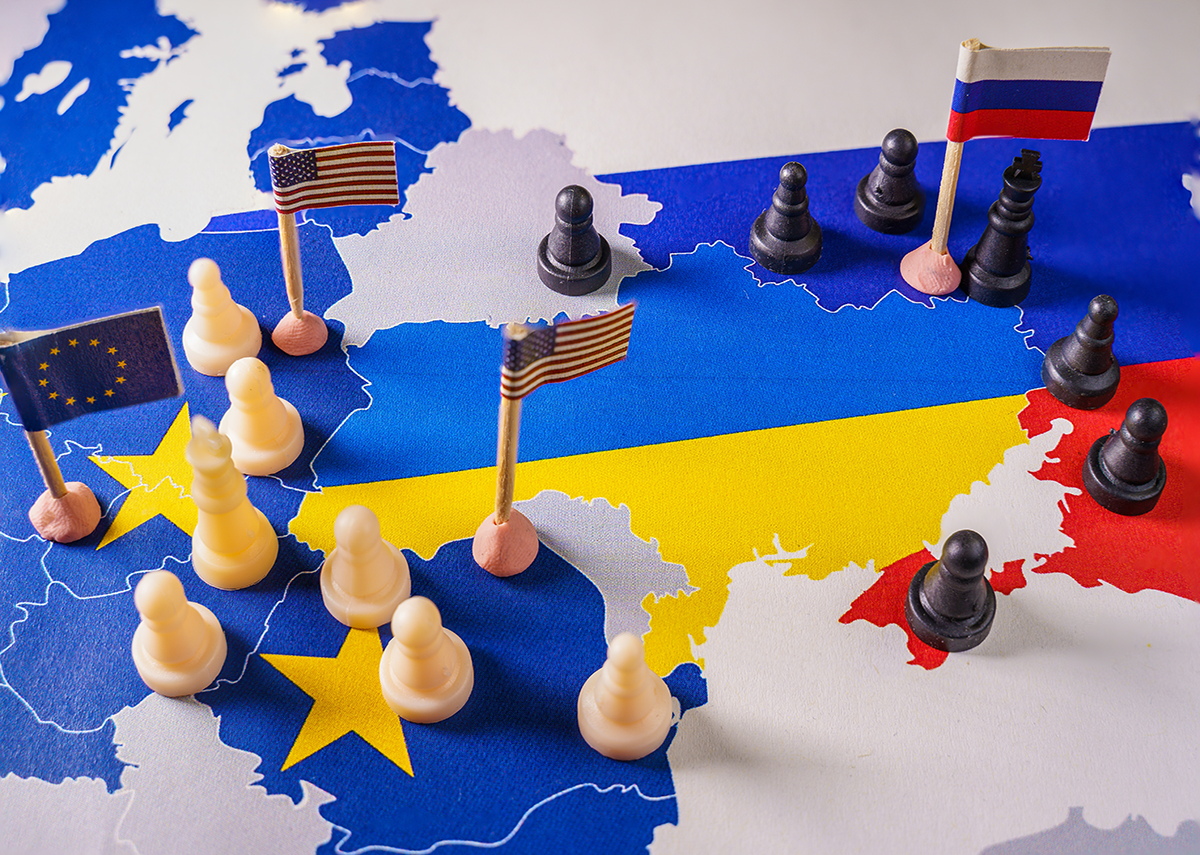For those who don't know it: War and Peace is a historical novel written in a realistic style by the Russian writer Leo Tolstoy. It is considered one of the most important works of world literature. It is a mixture of historical novel and military-political depictions.
An economic war is also a war for the supply chain
As has already been described countless times, globalization has put a lot of strain on the supply chain structure and made it vulnerable to unexpected crises beyond its control. But also in the relatively short time, strategic awareness was not raised.
This means that even in the future, should the corona pandemic subside, there will be no relief in sight along the supply chain in logistics or intralogistics.
While Russian nationalism is repeatedly invoked in the media in an attempt to explain the supposedly one-sided dispute between Russia and Ukraine, a look behind the scenes helps to further proceed and plan new logistics strategies with regard to the supply chain .
Ultimately, it is always economic interests and securing existing and new markets. In this case, it's not just about the country of Ukraine alone, but also about leveling out potential competitors who have an influence on national revenues such as jobs.
Gazprom, the top 1 company in Russia, is only in 7th place in an international industry comparison. In front of it are US companies such as ExxonMobil and Chevron. Great Britain and France are also represented. And also China in fifth place with PetroChina. A possible explanation why China does not clearly stand behind Russia on the Ukraine issue as expected?
With this escalation, Germany's attempt to free itself from an energy policy dependency through renewable energies will become a distant reality again if German policy does not consistently continue on its path.
A rogue who thinks evil of it - the question now is why Germany should enter into a gas emergency when Gazprom's market capitalization is just under 8% compared to the rest of the world? A gas emergency would occur if the USA, France and the UK, all members of NATO, did not supply us and did not want to do business with us.
The energy market is considered the most important industry of all. Anyone who is not ahead here will lose influence and influence on the markets that depend on it. This is not about the good or evil of political actors alone, but about market dominance and our associated prosperity. When viewed soberly, we are all beneficiaries and pawns of a system that has taken on a life of its own.
Whether the war was nationalistically provoked by Russia or whether there are economic interests of other countries behind it that consciously or unconsciously want to benefit from this supposedly one-sided dispute between Russia and Ukraine, the challenges for logistics and intralogistics during and after the Corona pandemic will be in relation to globalization not less. They are becoming more complex and complicated, disrupting most supply chain strategies.
Suitable for:
Leading oil and gas producers by market capitalization October 2021
Exxon Mobil has the highest market capitalization of any oil and gas producer in the world. As of October 4, 2021, the United States-based company had a market capitalization of $257.95 billion. Of the ten largest companies, five were classified as Big Oil companies. Indian conglomerate Reliance Industries, which operates the world's largest oil refining complex and is also active in retail and telecommunications, was second with a market capitalization of over $226 billion.
KPIs of the leading oil and gas companies
While the number of companies that are among the largest in their industry has hardly changed, their ranking varies depending on the metric used. Although ExxonMobil is often ranked first in terms of market capitalization, China's Sinopec was identified as the world's leading oil and gas company based on revenue in the 2020/2021 fiscal year, while ExxonMobil is ranked third. At the same time, state-owned companies such as Gazprom and PetroChina are the world's leading oil and gas companies in terms of employment. In 2021, they each employed more than 430,000 people.
Most Valuable Providers of Oil Equipment and Services
Canada-based Enbridge is the world's largest oil and gas equipment and services provider by market capitalization, with outstanding shares valued at $80.97 billion as of October 4, 2021. Oilfield service providers are typically not involved in oil production, but instead provide services to companies involved in exploration and production, such as: B. renting drilling rigs or transporting oil and gas to refineries and consumer markets.
Top global oil and gas companies based on market capitalization as of October 2021
- ExxonMobil, USA – $257.95 billion
- Reliance Industries, India – $226.5 billion
- Chevron, United States – $201.77 billion
- Royal Dutch Shell, UK – $173.36 billion
- PetroChina, China – $161.02 billion
- TotalEnergies, France – $126.24 billion
- Gazprom, Russia – $117.56 billion
- ConocoPhillips, US – $93.87 billion
- BP, UK – $91.19 billion
- Rosneft, Russia – $89.95 billion
Shareholder structure of the Gazprom gas company
The statistics show the shareholder structure of the gas company Gazprom in 2020. In the year mentioned, the Bank of New York Mellon owned around 17 percent of the shares in the world's largest natural gas production company Gazprom. Gazprom became a public company in 1992 and was previously a Russian state-owned company. In 2020, the Russian state's aggregate shares in Gazprom were just over 50 percent.
¹ As of December 31, 2020, the Russian state held 100% of Rosneftgaz shares.
² As of December 31, 2020, OAO Rosneftgaz held a total of 74.55% of the shares of OAO Rosgazifikatsiya.
³ American Depositary Receipt (ADR), stock certificates or depositary receipts issued by US depository banks. As of December 31, 2020, the Bank of New York Mellon traded with ADR on Gazprom shares in the specified amount.
Shareholder structure of the Russian gas company Gazprom in 2020
- Russian state – 38.37%
- OAO Rosneftegaz¹ – 10.97%
- OAO Rosgazifikatsiya² – 0.89%
- ADR certificates³ – 16.71%
- Other shareholders – 33.06%
NATO's gross domestic product (GDP) compared to Russia
Another attempt to explain the economic background why Russia wants to prevent NATO from having any influence on Ukraine while there is still time: NATO's eastward expansion also has an economic aspect and not just a purely security policy aspect.
The gross domestic product shows the economic performance of a country. It is calculated from all goods and services that were provided within the country's borders over a certain period of time. In comparison, Russia, once a major political power, is a dwarf, but it can still position itself strategically and maintain influence in the energy sector. Does the war now show that Russia is resorting to the last resort and is at its wits' end?
NATO member countries together generated an estimated gross domestic product (GDP) of around $37.17 trillion in 2020. This means that the NATO countries account for around 45 percent of the world's gross domestic product. The member states of the Shanghai Cooperation Organization (SCO) have significantly lower economic power, with a GDP of around 17.93 trillion US dollars.
What is NATO – North Atlantic Treaty Organization?
NATO is a military alliance that currently includes 30 European and North American countries. NATO's main tasks lie in the areas of security and defense policy, conflict prevention and crisis management, as well as disarmament and arms control. In 2014, NATO set the goal of each member country investing at least two percent of its gross domestic product in defense by 2025. So far only the USA, Greece, Estonia, Latvia and the United Kingdom have achieved this goal. See also the statistics on the share of military spending in gross domestic product in the NATO countries.
Shanghai Cooperation Organization (SCO)
The Shanghai Cooperation Organization (SCO) was founded in 2002 with the aim of strengthening trust and cooperation among the eight member states in various areas such as trade and security policy. The SCO comprises around 40% of the world's population and is seen by some observers as an international counterweight to NATO. The following states are members of the organization:
- China
- Kazakhstan
- Kyrgyzstan
- Russia
- Tajikistan
- Uzbekistan
- India (since 2017)
- Pakistan (since 2017)
Gross domestic product (GDP) of NATO and Russia in comparison in 2020
- NATO Total – $37,165 billion
- NATO Europe and Canada – $17,931 billion
- SCO Total – $17,970.35 billion
- China – $14,860.78 billion
- India – $2,592.58 billion
- Russia – $1,464.08 billion


